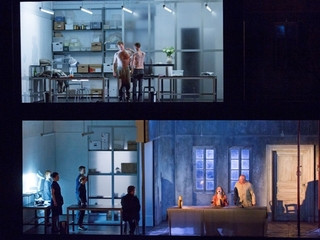|
Back
Theater of Cruelty New York
New York State Theater, Lincoln Center
08/11/2015 - & August 13, 15, 2015
George Benjamin: Written on Skin (American stage premiere)
Christopher Purves (The Protector), Barbara Hannigan (Agnès), Tim Mead (Angel 1, Boy), Victoria Simmonds (Angel 2, Marie), Robert Murray (Angel 3, John), David Alexander Parker, Laura Harling, Peter Hobday, Sarah Northgraves (Angel Archivists)
Mahler Chamber Orchestra, Alan Gilbert (Conductor)
Katie Mitchell (Director), Vicki Mortimer (Scenic and Costume Design), Jon Clark (Lighting Design)

The Set (© Richard Termine)
George Benjamin has written an opera which is almost inhumanly oppressive, relentless , complex and in 90 minutes almost impervious to light.
Not physically, of course. The three-tiered set had lights turning on and off in different compartments with alarming suddenness. Not for the stage effects (that would be cheap, and Mr. Benjamin and text-writer Martin Crimp are at the apex of their creative skills). But for an emotional power soaring over a thousand years.
The medieval troubadour tale from which Mr. Crimp took his words, could have been a Boccaccio anecdote. A rich 13th Century landowner (the Protector, played played with menace by baritone Christopher Purves) proudly “owns all the land and all the people on the land”. To assure his immortality, he employs a painter (the Boy, played by countertenor Tim Mead) famed for illuminated manuscripts, to give a picture of this proud man. He is to paint Paradise and Hell.
The Protector’s wife (his “property”, sung by that avatar of modern soprano music, Barbara Hannigan) has lingered in the ignorance of that time. She seduces the Boy, the Protector kills the Boy and feeds his heart to his wife.
But oh, what dimensions we have here. The wife arises from being the Protected to have a name–Agnès–not only does she become the symbol of the sensuous woman but she can destroy both other men. The Protector suffers from nightmares, not only believing his protected wife is not his own but that he too is attracted to the Boy. The Painter himself becomes victim and victor, his paintings and words, changing earthly paradise to hell, he prints words on the parchment (thus the symbol of the title) and these become magical talismans.
Add to this a complex staging. For the Boy is also a 21st Century Angel, working with other angels on the side and above the set of the Protector’s home. The angels are archivists, they are set dressers, they control the characters, allow them their Medieval rites (albeit with a few modern references) and at the end are totally transformed.
And now add a text which, despite the unfailing emotion, is actually disinterested. Rather than a mere line, the artist will narrate his/her words, “This is Paradise, says the Boy”. At times, the emotion becomes a shriek of personality, as when Agnès, screams out “Push our love into that man’s eyes like a hot needle”. But otherwise, we feel it is a tale told by the characters as the characters.

B. Hannigan, T. Meade (© Richard Termine)
The results are savage, inhuman, mercilessly spun out. The theatrical form could be compared to Alban Berg’s Wozzeck or Lulu with their sudden changes of scene, Berg’s homage to cinema. But where Berg was telling an agonizing story, Martin Crimp was delving deeper and deeper into the individual psyches, into the essences of political misanthropy, and into–what sounds like but isn’t–the awakening of the suffering female from her “protected” cocoon into a real world.
But Crimp adds more dimensions. On the side and top of the room are modern stage “props” rooms, where costumes are changed, the five main characters enter, sometimes in their parts, sometimes as “actors” and are dealt with by modern angels. We never know.
In a way, this is annoying. The story is so grotesque, Crimp’s text is so precise , that the momentary references to “airports’ or ”pornography” are jarring in a bad way. But just because Martin Crimp has collaborated with George Benjamin in a previous chamber opera, he knows his drama and is not simply a librettist. The story pushes on as though preordained. Whatever the simplicity of the original troubadour song, Martin Crimp tries to universalize the themes of cruelty and history and gender.
Above all, though, Alan Gilbert and the Mahler Chamber Orchestra triumph with George Benjamin’s shattering music. A student of Messiaen, Mr. Benjamin is as shattering as the words, augmenting the sounds with strange colors. The glass harmonica to work with the treble lines. Harsh percussion comes from the side, not to show dissonance but to accentuate the words themselves. That, though, is woven throughout a score which, from the first brassy conplex lines, is a catalogue of the frightful, the chilling, the highly arousing. We have no arias or monologues here. Yes, the singing rises in excitement, and–in the seduction scene (which looks like, but does not have the ugliness of Williams’s Streetcar)–a rare tenderness.
But in the final scenes of Written on Skin, Benjamin and Crimp present a dizzying yet somehow literate compendium of revenge, cannibalism, murder, and a strange slow-motion eternity.
No more can be said. This was the final performance (though Mr. Benjamin’s music is presented today by the International Contemporary Ensemble). Mr. Benjamin wrote the music especially for these powerful singers, and spent many hours speaking with them to find their own inner thoughts.
The result is more than unsettling. The opera is unnerving, unforgettable. We shall not see or hear the likes of this mesmerizing Theater of Cruelty, as true in the 13th Century as in today’s ISIS Caliphate. The combination of Crimp, Benjamin, Gilbert and the performing artists make it all too musically delicious and dramatically damnable.
Harry Rolnick
|